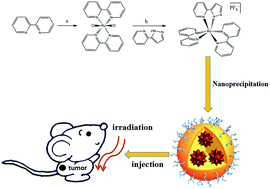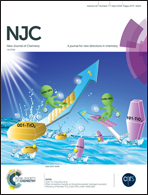Photochemical property of a Ru(ii) compound based on 3-(2-pyridyl)pyrazole and 2,2′-bipyridine for ablation of cancer cells
Abstract
Ru(II) compounds are potential candidates for photodynamic therapy (PDT). In the present study, a Ru(II) compound based on 3-(2-pyridyl)pyrazole (Hpypz) and 2,2′-bipyridine has been prepared and characterized. This compound can self-assemble to form nanoparticles (NPs) by nanoprecipitation in distilled water. These NPs with a mean size of 92 nm have good passive targeting by enhanced permeability and retention effect (EPR). In vitro studies on HeLa cells show that these NPs have high phototoxicity and a low IC50 (half-maximal inhibitory concentration) of only 8 μg mL−1 (12 μM), but they also have negligible dark toxicity. Moreover, such NPs can inhibit the migration of HeLa cells, indicating their potential to interfere with the transfer of tumors in vivo. Furthermore, in vivo investigations on nude mice demonstrate that such NPs can effectively inhibit the growth of the tumor. After treatment for 10 cycles, an obvious decrease in the tumor volume can be observed and in addition, the main organs (heart, liver, spleen, lung and kidney) suffer no damage, which indicates the high phototoxicity, low toxicity and excellent biocompatibility of these NPs.



 Please wait while we load your content...
Please wait while we load your content...